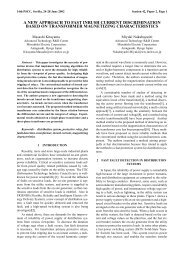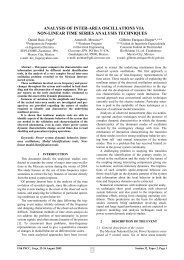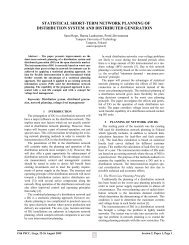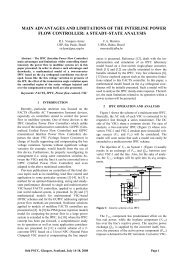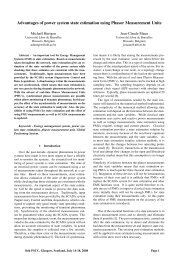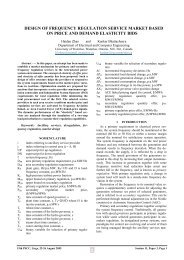comparison of practical fault ride-through capability for mv - PSCC
comparison of practical fault ride-through capability for mv - PSCC
comparison of practical fault ride-through capability for mv - PSCC
You also want an ePaper? Increase the reach of your titles
YUMPU automatically turns print PDFs into web optimized ePapers that Google loves.
Reduction in <strong>fault</strong> clearing time can be reached by reducing<br />
time grading <strong>of</strong> two successive relays or applying<br />
differential protection.<br />
The nowadays undervoltage protection settings in the<br />
Netherlands are such that at voltage levels below 0.8<br />
p.u. all DG-units are disconnected. Comparing the current<br />
settings with the CCT-curves displayed in Figure<br />
13, it can be concluded that the settings <strong>of</strong> the undervoltage<br />
protection can be altered without instability <strong>of</strong><br />
the DG-units.<br />
Based on the data in Figure 12 with the current settings,<br />
the frequency <strong>of</strong> disconnection is 0.37 times per<br />
annum or 9.3 % <strong>of</strong> all the voltage dips (calculated by<br />
summing up all the frequencies <strong>of</strong> the voltage dips below<br />
0.8 p.u.). By applying the developed CCT-curves in<br />
the undervoltage protection the frequency <strong>of</strong> disconnection<br />
can be reduced to 0.02 times per annum or 0.5 % <strong>of</strong><br />
all the voltage dips. This figure holds <strong>for</strong> the wind turbine,<br />
while <strong>for</strong> the CHP-plant there are no disconnections<br />
at all. Thus, the availability <strong>of</strong> the DG-units can be<br />
increased significantly by adjusting the under-voltage<br />
protection in accordance with the CCT-curves.<br />
The <strong>fault</strong> <strong>ride</strong>-<strong>through</strong> capabilities <strong>of</strong> the wind turbine<br />
can be improved by adding a crowbar to the DFIG. The<br />
crowbar separates the rotor side converter from the rotor<br />
circuit. In [10] the operation <strong>of</strong> the crowbar is simulated<br />
and it is demonstrated that <strong>fault</strong> <strong>ride</strong> <strong>through</strong> during and<br />
after a deep voltage dip (0 V remains, 150 ms) is possible.<br />
6 CONCLUSION<br />
In this paper the <strong>ride</strong>-<strong>through</strong> behavior <strong>of</strong> a CHPplant<br />
and a DFIG-based wind turbine is studied. Based<br />
on the data <strong>of</strong> an existing power system including reliability<br />
data a voltage dip pr<strong>of</strong>ile at the generator terminals<br />
is established. This pr<strong>of</strong>ile is combined with the<br />
<strong>fault</strong> clearing times <strong>of</strong> the test system which have led to<br />
a plot where the depth and duration <strong>of</strong> the voltage dips<br />
are indicated. Using the single machine infinite network<br />
scheme the CCT-curves <strong>of</strong> the DG-units are derived.<br />
From stability point <strong>of</strong> view these curves show that it is<br />
not necessary to disconnect the DG-units at a voltage<br />
level <strong>of</strong> 0.8 p.u. (the present setting <strong>of</strong> DG undervoltage<br />
protection in the Netherlands), but at lower levels, which<br />
are dependent on the critical clearing times. These CCTcurves<br />
can be implemented in the undervoltage relay<br />
and prevent switching <strong>of</strong>f during a voltage dip caused by<br />
a <strong>fault</strong> in a HV- or neighboring MV-grid. In some cases<br />
disturbances in the 20 kV grid lead to unstable operation.<br />
This can be prevented by adjusting the <strong>fault</strong> clearing<br />
time or applying differential protection. For DFIG<br />
wind turbines transient stability can be significantly<br />
improved by introduction <strong>of</strong> crowbar protection and<br />
switching between different control strategies <strong>for</strong> normal<br />
operation and <strong>fault</strong> conditions.<br />
The method presented in this paper can be followed<br />
in all locations <strong>of</strong> the grid and prevent ambitious disconnection<br />
<strong>of</strong> DG.<br />
REFERENCES<br />
[1] B.M. Buchholz, “Dynamic Simulation <strong>of</strong> Renewable<br />
Energy Sources and Requirements on Fault Ride<br />
Through Behaviour”, Power Engineering Society<br />
General Meeting, Montreal, Canada, June, 2006<br />
[2] F.M. Gatta, F. Ilicento, S. Lauria and P. Masato,<br />
“Behaviour <strong>of</strong> Dispersed Generation in Distribution<br />
Networks During System Disturbances. Measures to<br />
prevent disconnection”, CIRED 17th International<br />
Conference on Electricity Distribution, Barcelona,<br />
May 2003<br />
[3] I. Erlich and U. Bachmann, “Grid Code Requirements<br />
Concerning Connection and Operation <strong>of</strong><br />
Wind Turbines in Germany”, IEEE Power Engineering<br />
Society General Meeting, San Francisco, Cali<strong>for</strong>nie,<br />
USA, 2005<br />
[4] G. Daniëls, “Betrieb von Mittelspannungsnetzen mit<br />
hoher Blockheizkraftwerkeinspeisung”, Band 39,<br />
dissertation Rheinisch-Westfälischen Technische<br />
Hochschule Aachen, 1996 (in German)<br />
[5] “SimPowerSystems User's Guide”, The Mathworks,<br />
2007<br />
[6] A.D. Hansen and G. Michalke, “Voltage grid support<br />
<strong>of</strong> DFIG wind turbines during grid <strong>fault</strong>s”,<br />
European Wind Energy Conference & Exhibition,<br />
Milan, Italy, May 2007<br />
[7] J.F.G. Cobben, “Power Quality: Implications at the<br />
Point <strong>of</strong> Connection”, PhD Thesis, ISBN: 978-90-<br />
386-1030-6, Eindhoven University <strong>of</strong> Technology,<br />
June 2007<br />
[8] R. Luiten et al, “Reliability <strong>of</strong> Electricity Networks<br />
in the Netherlands <strong>for</strong> 2006”, KEMA, May 2007 (in<br />
Dutch)<br />
[9] M.H.J. Bollen, “Understanding Power Quality Problems,<br />
Voltage Sags and Interruptions”, Piscataway,<br />
NJ: IEEE press, 1999<br />
[10]I. Erlich, H. Wrede and C. Feltes, “Dynamic Behavior<br />
<strong>of</strong> DFIG-Based Wind Turbines during Grid<br />
Faults”, PCC Power Conversion Conference, Nagoya,<br />
Japan, April, 2007<br />
16th <strong>PSCC</strong>, Glasgow, Scotland, July 14-18, 2008 Page 6



